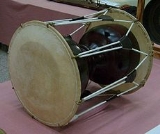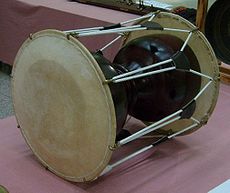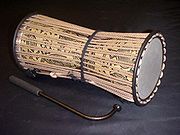
Hourglass drum
Encyclopedia


Membranophone
A membranophone is any musical instrument which produces sound primarily by way of a vibrating stretched membrane. It is one of the four main divisions of instruments in the original Hornbostel-Sachs scheme of musical instrument classification....
, or drum
Drum
The drum is a member of the percussion group of musical instruments, which is technically classified as the membranophones. Drums consist of at least one membrane, called a drumhead or drum skin, that is stretched over a shell and struck, either directly with the player's hands, or with a...
, characterized by an hourglass
Hourglass
An hourglass measures the passage of a few minutes or an hour of time. It has two connected vertical glass bulbs allowing a regulated trickle of material from the top to the bottom. Once the top bulb is empty, it can be inverted to begin timing again. The name hourglass comes from historically...
shape. They are also known as waisted drums. Drumheads are attached by laces, which may be squeezed during a performance to alter the pitch.
The category also includes pellet drum
Pellet drum
Pellet drums are a class of membranophone, or drum, characterized by their construction and manner of playing. They have two heads , and two pellets, each connected by a cord to the drum...
s such as the damaru
Damaru
A damaru or damru is a small two-headed drum shaped like an hourglass. The drum is typically made of wood, with leather drum heads at both ends; the damaru might also be made entirely out of human skulls...
, although not all pellet drums are hourglass shaped (such as the Korean do, nodo, noedo, and yeongdo, which are barrel shaped).
Hourglass drums exists in most regions of the world, but have very different construction methods, dimensions, purposes and playing methods. The label of hourglass drum is hence as generic as the label for bowed instrument or reed instrument. Thus the designation of Hourglass drum is used as a category in general instrument construction and does not refer to any particular uniform instrument.
See also
- DamaruDamaruA damaru or damru is a small two-headed drum shaped like an hourglass. The drum is typically made of wood, with leather drum heads at both ends; the damaru might also be made entirely out of human skulls...
(Indian subcontinent) - UdukaiUdukaiThe udukai is a drum used in folk music and prayers in South India. This comes in the Carnatic classical music of India.The Damru in the hands of Lord Shiva is also referred to as Udukkai....
(South India) - UrumeeUrumeeThe urumee is a double-headed hourglass-shaped drum from the state of Tamil Nadu, South India. Two skin heads are attached to a single hallow, often intricately carved wooden shell. The preferred wood is jackwood, although other wood may be used...
(India) - Dhad sarangiDhad sarangiThe dhad is a small hourglass-shaped drum of the Damru style. Held in one hand, it is struck on either side, with the other hand holding the skinned sides vertically or horizontally...
(India, Pakistan) - IdakkaIdakkaThe idakka , also spelt edaykka, is an hourglass-shaped drum from Kerala in south India. This handy percussion instrument is very similar to the pan-Indian damaru. While the damaru is played by rattling knotted cords against the resonators, the idakka is played with a stick...
(India)
- GalgoGalgoThe galgo is a traditional Korean drum. The drum has an hourglass-shaped wooden body and two drum heads of identical diameter, similar to the janggu. Compared to the janggu, the galgo is fitted with a sound-adjusting funnel different from that of the janggu...
(Korea) - JangguJangguThe janggu or sometimes called seyogo is the most widely used drum used in the traditional music of Korea. It is available in most kinds, and consists of an hourglass-shaped body with two heads made from animal skin...
(Korea) - JieguJieguJiegu is an alternative spelling of Gyêgu the town in Qinghai provinceThe jiegu was a drum used in ancient China...
(China) - KakkoKakkoThe is a Japanese double-headed drum. One way in which the kakko differs from the regular taiko drum is in the way in which it is made taut. Like the Shime-Daiko and tsuzumi, the skin of the heads are first stretched over metal hoops before they are placed on the body, tying them to each other and...
(Japan) - ŌtsuzumiOtsuzumiThe , also known as the ōkawa, is an hourglass-shaped Japanese drum. It is a larger version of the tsuzumi, or kotsuzumi and is used in traditional Japanese theater and folk music. Its appearance and the sound it produces are slightly different than that of the tsuzumi...
(Japan) - TsuzumiTsuzumiThe is a Japanese drum of Chinese/Indian origin. It consists of a wooden body shaped like an hourglass, and it is taut, with two drum heads with cords that can be squeezed or released to increase or decrease the tension of the heads respectively...
(also called kotsuzumi) (Japan)
- Talking drum also called dundun, kalangu, donno, or tama (West Africa)
- Batá drum (Cuba, West Africa)

